Do you have a question about the Husqvarna FS 9900 D and is the answer not in the manual?
Lists essential practices and prohibitions for safe machine operation.
Explains various symbols indicating safety, mandatory actions, and machine components.
Details risks from toxic exhaust gases and high noise levels, requiring specific precautions.
Covers risks from cutting dust (silica) and California Prop 65 warnings.
Provides noise emissions and vibration levels for different machine models.
Illustrates various decals and their specific placement on the machine for identification and safety.
Detailed technical data including dimensions, engine, transmission, and performance for various models.
Provides guidance on adjusting blade speed for different blade sizes on specific saw types.
Details engine type and warranty registration process for the machine's diesel engine.
Outlines checks before starting and a schedule for routine maintenance tasks.
Identifies and explains the function of various controls and indicators on the machine's console.
Details parts related to the blade, guard, and shaft assembly.
Illustrates gearbox, hood latch, and related components for single and multi-speed models.
Identifies components related to the machine's axles, wheels, and hydraulic systems.
Details components related to air, fuel, oil, coolant, and hydraulic fluid systems.
Shows locations for lifting, oil checks, guards, and guides for maintenance and operation.
Describes intended uses and provides a table for blade depth and size compatibility.
Provides instructions for moving the saw with the engine off and on, including safety precautions.
Details procedures for transporting the saw, including blade removal and securing.
Lists essential checks to perform before starting the machine for safe operation.
Step-by-step guide on how to properly install a diamond blade onto the machine.
Detailed procedure for starting the machine's engine and preparing it for operation.
Instructions for safely stopping the machine, including emergency procedures.
Provides troubleshooting steps for common issues like engine stalling or blade stoppage.
Explains how to adjust the axle for precise straight-line cutting operations.
Covers regular maintenance tasks like cleaning, lubrication, and fluid checks.
Details how to check and adjust the tension of the V-belts for optimal saw performance.
Guides on maintaining the hydraulic system, including filter changes and fluid levels.
Offers general tips for safe operation, bolt tightening, and blade storage.
Explains how to adjust speeds for different blade sizes and gearbox configurations.
Lists available accessories like blade guards, weights, and optional kits for customization.
Discusses configurations for 60-inch diameter blades and associated adjustments.
Provides information on obtaining repair services and ordering replacement parts.
Outlines checks before starting and a schedule for routine maintenance tasks.
Identifies and explains the function of various controls and indicators on the machine's console.
Details parts related to the blade, guard, and shaft assembly.
Illustrates gearbox, hood latch, and related components for single and multi-speed models.
Identifies components related to the machine's axles, wheels, and hydraulic systems.
Details components related to air, fuel, oil, coolant, and hydraulic fluid systems.
Shows locations for lifting, oil checks, guards, and guides for maintenance and operation.
Describes intended uses and provides a table for blade depth and size compatibility.
Provides instructions for moving the saw with the engine off and on, including safety precautions.
Details procedures for transporting the saw, including blade removal and securing.
Lists essential checks to perform before starting the machine for safe operation.
Step-by-step guide on how to properly install a diamond blade onto the machine.
Detailed procedure for starting the machine's engine and preparing it for operation.
Instructions for safely stopping the machine, including emergency procedures.
Provides troubleshooting steps for common issues like engine stalling or blade stoppage.
Explains how to adjust the axle for precise straight-line cutting operations.
Covers regular maintenance tasks like cleaning, lubrication, and fluid checks.
Details how to check and adjust the tension of the V-belts for optimal saw performance.
Guides on maintaining the hydraulic system, including filter changes and fluid levels.
Offers general tips for safe operation, bolt tightening, and blade storage.
Explains how to adjust speeds for different blade sizes and gearbox configurations.
Lists available accessories like blade guards, weights, and optional kits for customization.
Discusses configurations for 60-inch diameter blades and associated adjustments.
Provides information on obtaining repair services and ordering replacement parts.
Outlines checks before starting and a schedule for routine maintenance tasks.
Lists essential practices and prohibitions for safe machine operation.
Explains various symbols indicating safety, mandatory actions, and machine components.
Details risks from toxic exhaust gases and high noise levels, requiring specific precautions.
Covers risks from cutting dust (silica) and California Prop 65 warnings.
Provides noise emissions and vibration levels for different machine models.
Illustrates various decals and their specific placement on the machine for identification and safety.
Detailed technical data including dimensions, engine, transmission, and performance for various models.
Provides guidance on adjusting blade speed for different blade sizes on specific saw types.
Details engine type and warranty registration process for the machine's diesel engine.
Outlines checks before starting and a schedule for routine maintenance tasks.
Identifies and explains the function of various controls and indicators on the machine's console.
Details parts related to the blade, guard, and shaft assembly.
Illustrates gearbox, hood latch, and related components for single and multi-speed models.
Identifies components related to the machine's axles, wheels, and hydraulic systems.
Details components related to air, fuel, oil, coolant, and hydraulic fluid systems.
Shows locations for lifting, oil checks, guards, and guides for maintenance and operation.
Describes intended uses and provides a table for blade depth and size compatibility.
Provides instructions for moving the saw with the engine off and on, including safety precautions.
Details procedures for transporting the saw, including blade removal and securing.
Lists essential checks to perform before starting the machine for safe operation.
Step-by-step guide on how to properly install a diamond blade onto the machine.
Detailed procedure for starting the machine's engine and preparing it for operation.
Instructions for safely stopping the machine, including emergency procedures.
Provides troubleshooting steps for common issues like engine stalling or blade stoppage.
Explains how to adjust the axle for precise straight-line cutting operations.
Covers regular maintenance tasks like cleaning, lubrication, and fluid checks.
Details how to check and adjust the tension of the V-belts for optimal saw performance.
Guides on maintaining the hydraulic system, including filter changes and fluid levels.
Offers general tips for safe operation, bolt tightening, and blade storage.
Explains how to adjust speeds for different blade sizes and gearbox configurations.
Lists available accessories like blade guards, weights, and optional kits for customization.
Discusses configurations for 60-inch diameter blades and associated adjustments.
Provides information on obtaining repair services and ordering replacement parts.
Outlines checks before starting and a schedule for routine maintenance tasks.
Identifies and explains the function of various controls and indicators on the machine's console.
Details parts related to the blade, guard, and shaft assembly.
Illustrates gearbox, hood latch, and related components for single and multi-speed models.
Identifies components related to the machine's axles, wheels, and hydraulic systems.
Details components related to air, fuel, oil, coolant, and hydraulic fluid systems.
Shows locations for lifting, oil checks, guards, and guides for maintenance and operation.
Describes intended uses and provides a table for blade depth and size compatibility.
Provides instructions for moving the saw with the engine off and on, including safety precautions.
Details procedures for transporting the saw, including blade removal and securing.
Lists essential checks to perform before starting the machine for safe operation.
Step-by-step guide on how to properly install a diamond blade onto the machine.
Detailed procedure for starting the machine's engine and preparing it for operation.
Instructions for safely stopping the machine, including emergency procedures.
Provides troubleshooting steps for common issues like engine stalling or blade stoppage.
Explains how to adjust the axle for precise straight-line cutting operations.
Covers regular maintenance tasks like cleaning, lubrication, and fluid checks.
Details how to check and adjust the tension of the V-belts for optimal saw performance.
Guides on maintaining the hydraulic system, including filter changes and fluid levels.
Offers general tips for safe operation, bolt tightening, and blade storage.
Explains how to adjust speeds for different blade sizes and gearbox configurations.
Lists available accessories like blade guards, weights, and optional kits for customization.
Discusses configurations for 60-inch diameter blades and associated adjustments.
Provides information on obtaining repair services and ordering replacement parts.
Outlines checks before starting and a schedule for routine maintenance tasks.
| Engine manufacturer | Husqvarna |
|---|---|
| Arbor size | 1 in |
| Sound power level | 107 dB(A) |
| Blade diameter max | 14 in |
| Fuel Capacity | 0.6 liters |
| Fuel tank capacity | 0.6 liters |
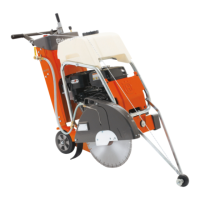
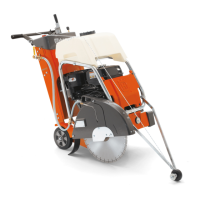




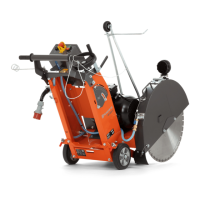
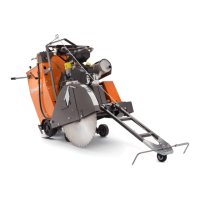
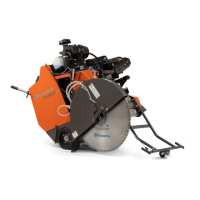
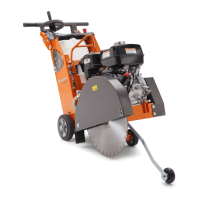
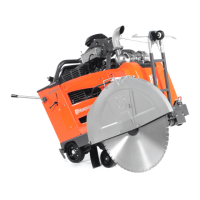
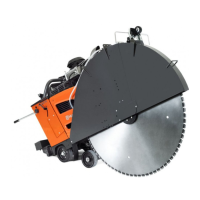
